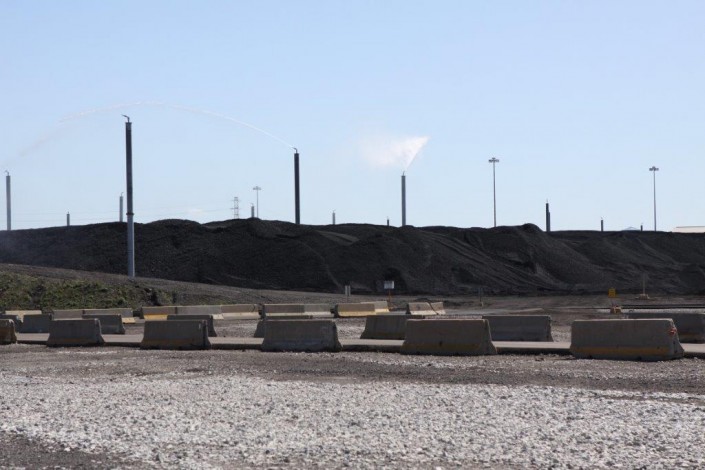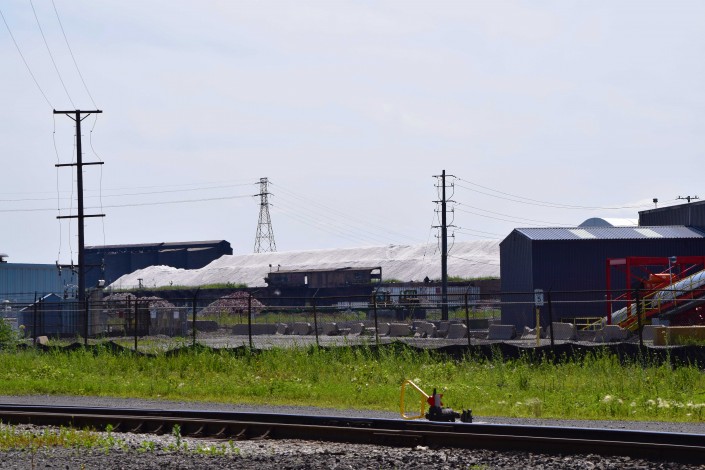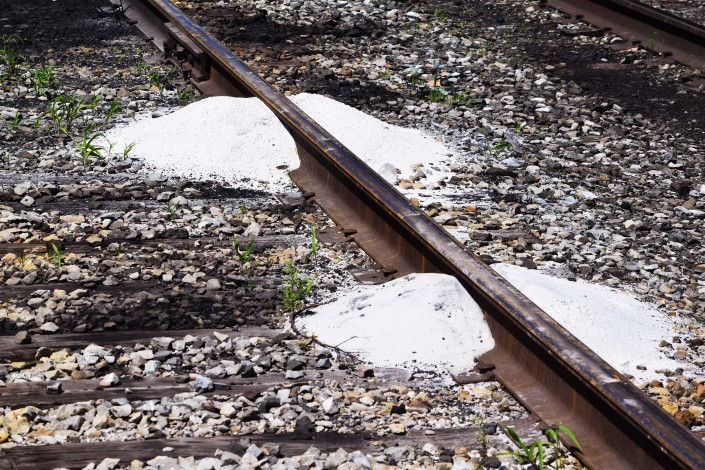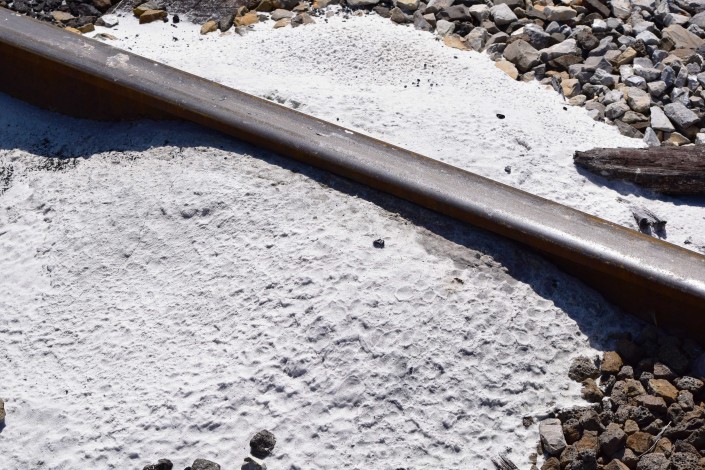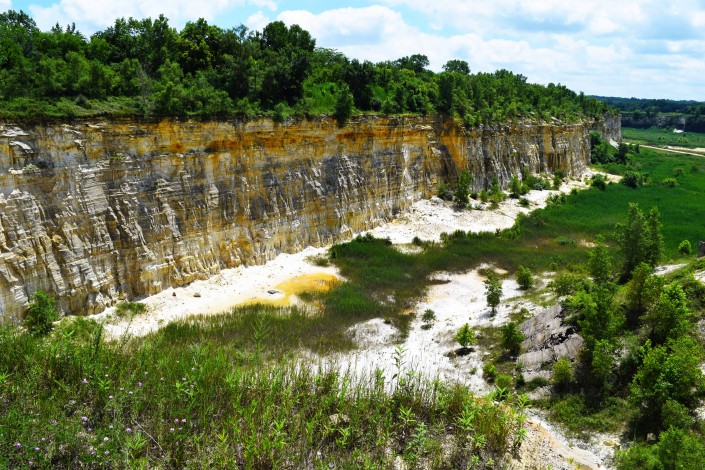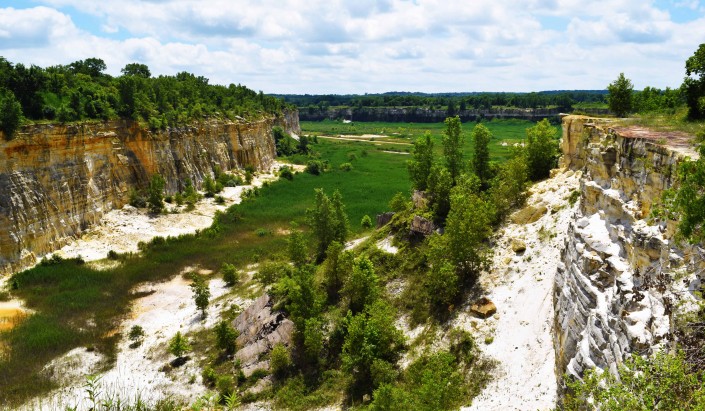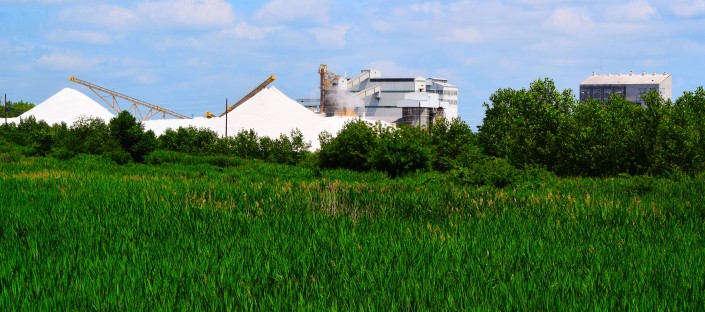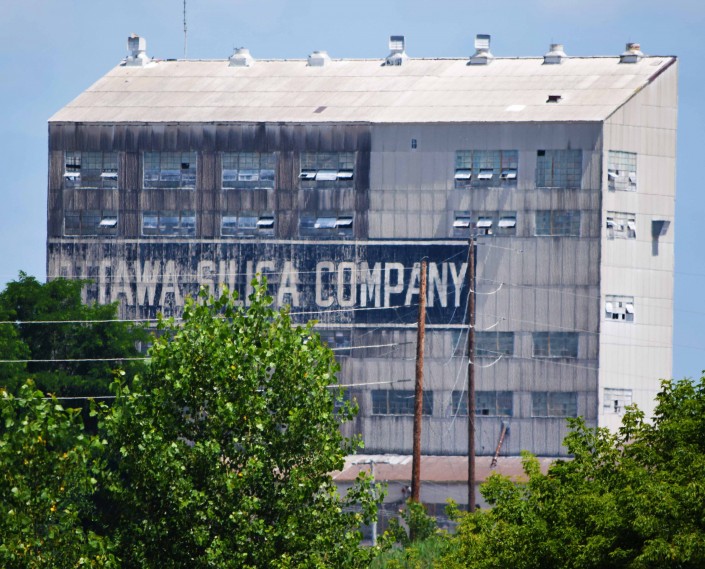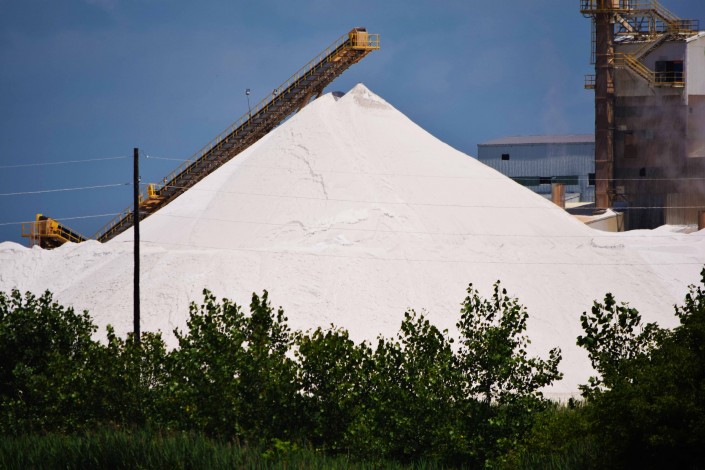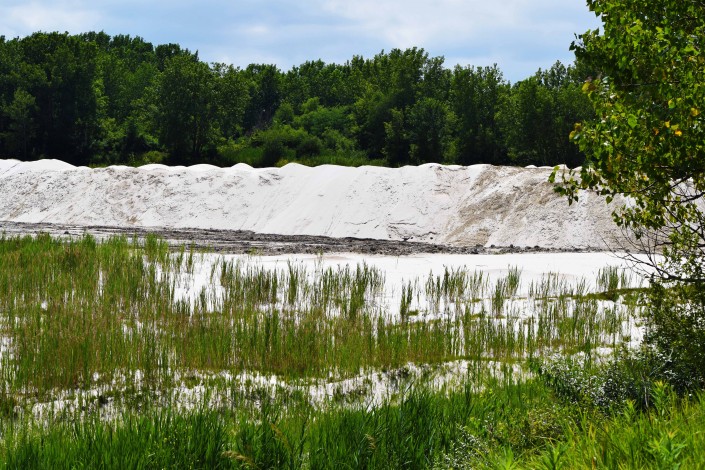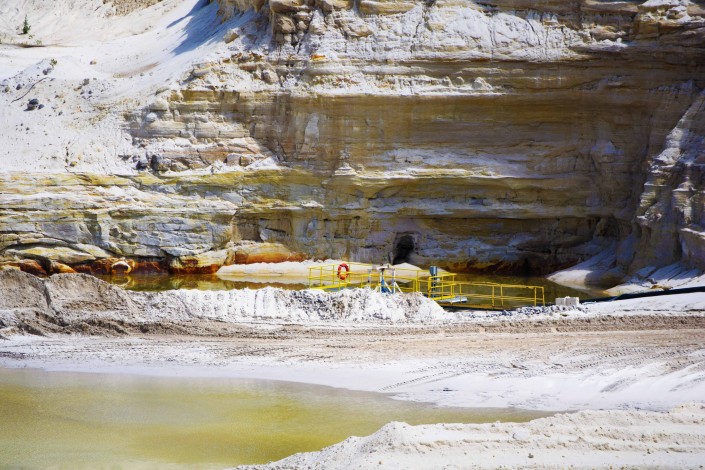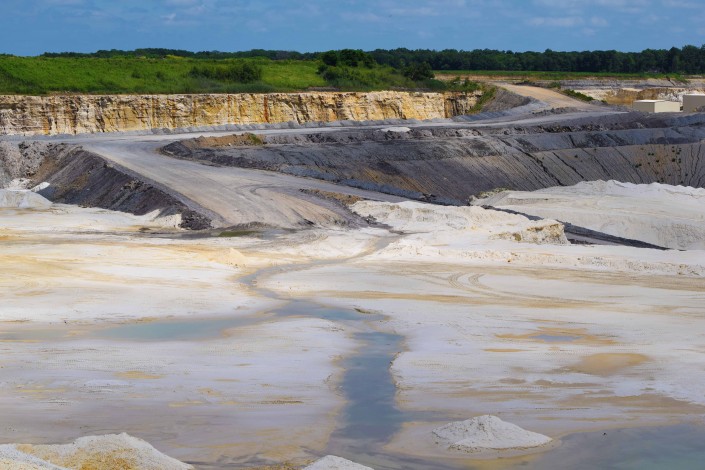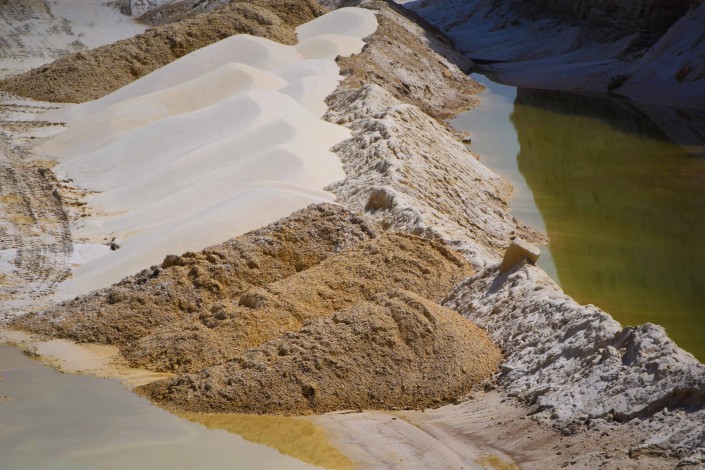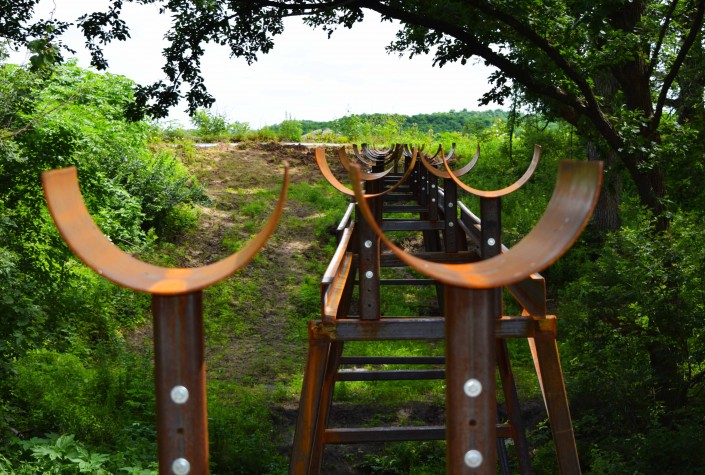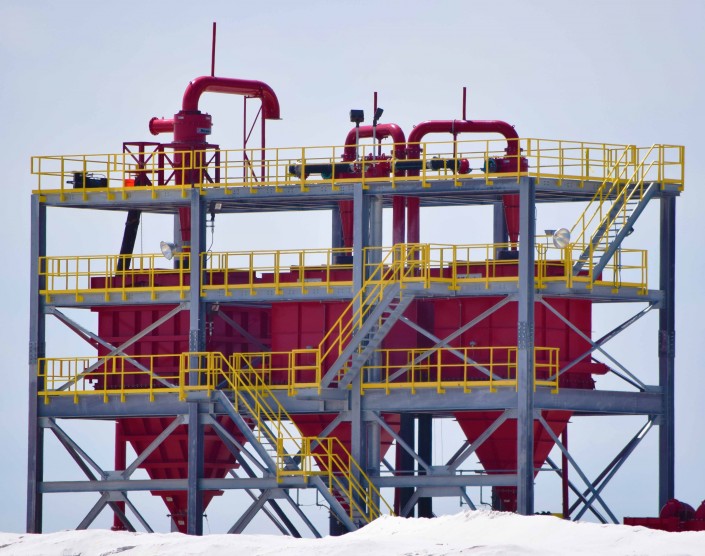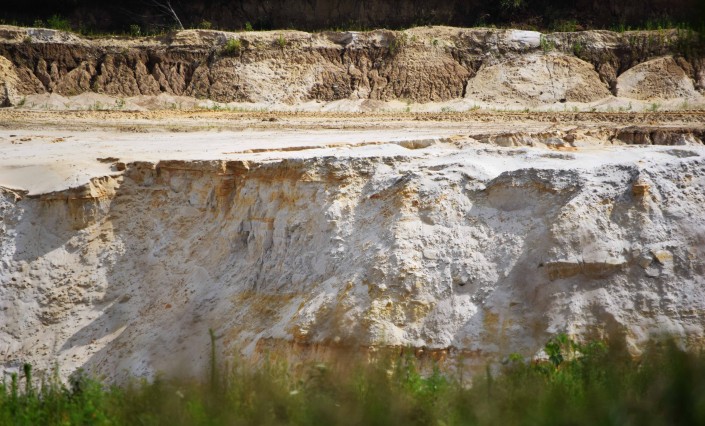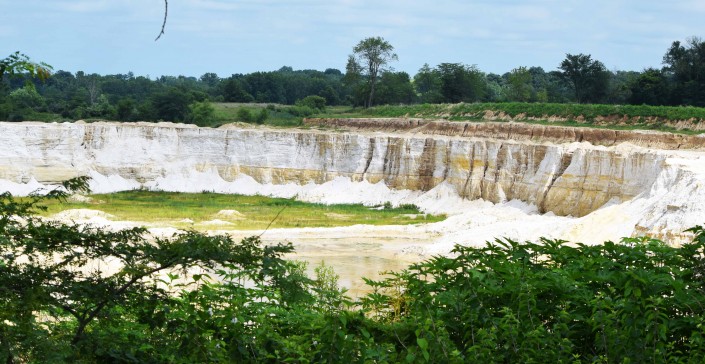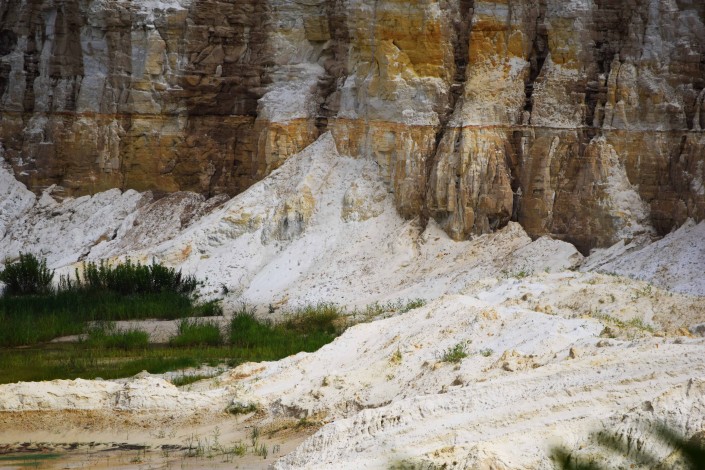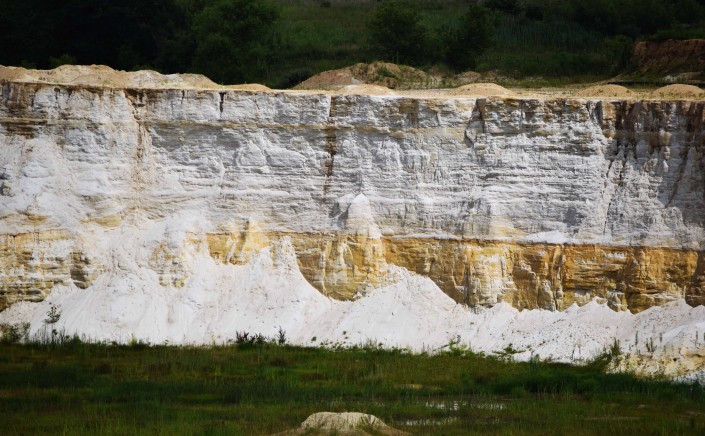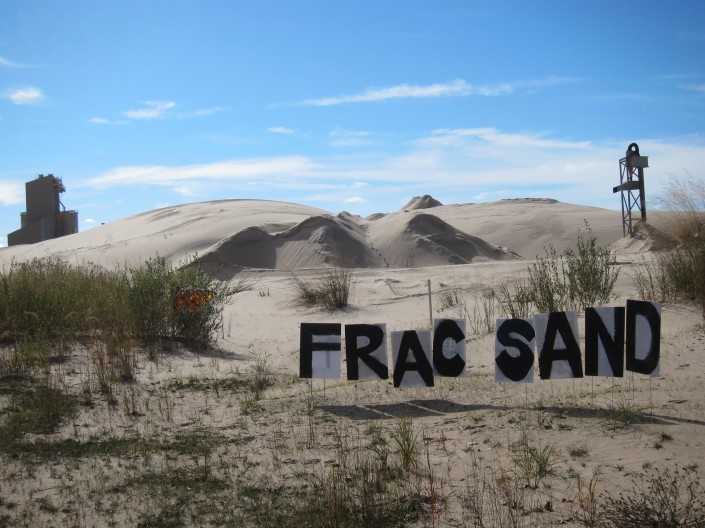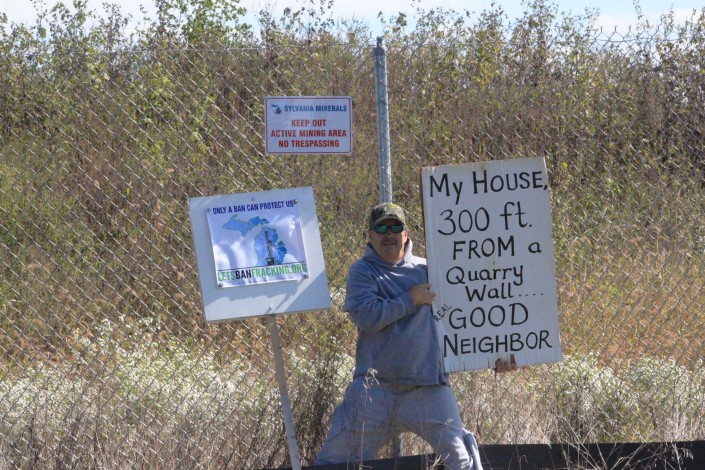7 Sand Mining Communities, 3 States, 5 Months – Part 2
Ludington State Park, Sargent Sand’s Mine, and US Silica and Sylvania Minerals
By Ted Auch, Great Lakes Program Coordinator
When it comes to high-volume hydraulic fracturing (HVHF), frac sand mining may be the most neglected aspect of the industry’s footprint. (HVHF demand on a per-well basis is increasing by 8% per year.)
To help fill this gap I decided to head out on the road to visit, photograph, and listen to the residents of this country’s primary frac sand communities. This multimedia perspective is part of our ongoing effort to map and quantify the effects of silica sand mining on communities, agriculture, wildlife, ecosystem services, and watersheds more broadly. Below is my follow up attempt to give The FracTracker Alliance community a sense of what residents are hearing, seeing, and saying about the silica sand mining industry writ large, through a tour of 7 sand mining communities – part 2. Read part 1.
Monroe County, MI
Monroe County, Michigan is approximately 22 miles south on I-75 from downtown Detroit with similar demographic differences to the Chicago-LaSalle County, IL comparison we made during the first part of this series. South Rockwood lies along the Northeastern edge of Monroe County and the Monroe-Wayne County border, and is consequently at the intersection of Detroit’s sprawl and rural Michigan.
Monroe County and nearly all of South Rockwood is underlain by one of the purest sandstone formations in North America. The Sylvanian Sandstone formation lies beneath 20% of Monroe County stretching from the aforementioned Wayne County border south-southwest to Lucas County, OH (Fig. 1). It is this formation that mining stalwarts such as US Silica and the appropriately named Sylvanian Minerals are mining for frac sands. Not only is the silica pure, but it is also extremely close to the surface. The region, conveniently, is situated at the crossroads of numerous rail lines capable of transporting the sand to shale plays in the east and North Dakota alike.
US Silica and Sylvanian Minerals are neighbors at the corner of Ready and Armstrong Roads in South Rockwood, with the former adjacent to I-75’s southbound lanes (Fig. 2). As of fall 2011, Sylvanian Minerals hadn’t even broken ground on its initial stab at mining frac sands. Presently the two firms have altered nearly 650 acres, or 40% of the community, with the potential to mine an additional 494 acres. These plans suggest that these two companies could collectively alter 72% of the community’s topography.
This domination of the landscape and commerce concerns many South Rockwood citizens including Sylvanian’s immediate neighbor Doug Wood, who has been the industry’s primary citizen watchdog over the last couple years (photo below).
Mr. Wood was generous enough to let us climb to the top of his barn to snap some photos of the mine. Mr. Wood witnessed the foundation of his home become compromised by the numerous blasting events down in Sylvanian’s mine, and only recently found out that the collective activity at the mines is going to force exit 26 off I-75 to be rerouted to Ready Road, converting this sleepy road into the primary entrance/exit for mine-related traffic. In addition, with the approval of Michigan’s Governor Rick Snyder, US Silica’s Telegraph Road Mine proposal has Mr. Wood and his neighbors worried about the safety of their families, the air pollution they inhale from the dust and potentially airborne silica, and the truck traffic related noise, which will all undoubtedly influence their health and quality of life.
The primary take-home message from this stop on my tour was that we have only seen the tip of the iceberg with respect to the potential of frac sand mining to literally and figuratively alter communities. Other affected areas such as South Rockwood could learn quite a bit from the likes of LaSalle County, IL residents Anna Mattes, Tom Skomski, and Ashley Williams.
On to the dunes of Western Michigan and Ludington State Park!
Ludington State Park and Sargent Sand’s Mine
After several days in Grand Rapids, I traveled to Ludington State Park in Michigan (see Fig 4 below), along with documentarian/drone pilot Tom Gunnels and Kent County Water Conservation’s Stephanie Mabie. Our destination was the camp of Linda and Ron Daul, the residents spearheading an effort to make Sargent Sand more accountable and transparent in its mining operations. There camp is also located within and adjacent to one of the most sensitive ecosystems in North America.
This is a documentary produced by Tom Gunnels and his Hive•Mind team that incorporated interviews and drone footage from our Ludington/Sargent Sand mine tour August, 2015.
Ms. Daul was kind enough to organize a tour of the mine, Ludington State Park, and northern hardwood forest for us, as well as journalist Aaron Selbig, who produced a piece on the tour for Interlochen Public Radio. The scenery sans the sand mining infrastructure, noise, and related truck traffic was beautiful in this little corner of Michigan roughly half way between Grand Rapids and Traverse City.
Great Lakes sand dunes
Michigan’s unique and threatened dune ecosystems – and associated Jack Pine (Pinus banksiana) “plains” or “barrens” ecosystem1 – comprise of 116 square miles of coastline along Lake Michigan. Unfortunately, they are simultaneously deprived of the fire regimes they require to regenerate, and are targets for the production of frac sands with Ludington State Park being the primary example. This makes the feasibility of reclaiming original plant communities dubious at best. (There have been mixed results associated with reclamation efforts, for example, at the former Rosy Mound Standard Sand Corporation’s mine 80 miles due south in Grand Haven, see Fig. 5.)
The largest obstacle to reclamation of sand mines along Lake Michigan is the inability of practitioners to document and replicate the many “microenvironments,” which as Peterson and Dersch pointed out:
…are the small environments created by differences in temperature, moisture, and light intensity within the sand dune ecosystem. Examination of these small environments is essential to a clear understanding of the ‘whole’ ecosystem. The diversity of organisms in sand dune areas is made possible by the variety of habitats found in relatively small areas. Any alteration of the dune which homogenizes the ecosystem will allow less diversity of plants and animals.
The Great Lakes dune complex requires perennial vegetation, wind, and sand for continued formation and stabilization with a complex – and specifically adapted – mosaic of lichens, fungi, mosses, grasses, wildflowers, shrubs, and trees arranged in a complicated and multi-layered manner across much of Western Michigan’s lakeshore. As Michigan’s DNR put it:
Without sand dune plants, the integrity and preservation of a stable dune complex cannot exist.
In combination with the Michigan Supreme Court’s constant fiddling of the intent and letter of mineral extraction law, namely the “very serious consequences” clause in House Bill 4746 (2011), you have the makings of a scenario that could eliminate upwards of 16 square miles of Michigan’s critical dunes in the coming years or 9-14% of the entire complex.2
Examples of this unique situation and the threats from Sargent Sand’s expansion include this dune, which is among the largest in Ludington State Park’s 2,820 acres. The Ludington Dunes are also home to the threatened Pitcher’s Thistle (Cirsium pitcheri) with the LSP encompassing one of the world’s two largest populations of this species according to Michigan’s Department of Natural Resources. Interestingly, the US Fish & Wildlife Service does not explicitly or implicitly list sand mining as one of their reasons why the species is threatened.
In addition to Pitcher’s Thistle, systems – like those found along the western edge of Michigan – are home to more than 15 endemic, or nearly so, plant species such as:
- Wormwood (Artemisia campestris, aka the source of Absinthe),
- The early colonizer sea-rocket (Cakile edentula),
- Clustered Broom-Rape (Orobanche fasciculata),
- Harebell (Cakile edentula, at the edge of Sargent Sand’s Ludington mine), and
- Hoary Puccoon (Lithospermum canescens), and the species most responsible for dune stabilization Marram Grass (Ammophila sp.).
Additionally, these dunes are critical to the life-cycles of more than 10 different species of birds, reptiles, and herbivores including the Eastern Hog-nosed Snake, Eastern Box Turtle, American Goldfinch, and everybody’s favorite, the White-Tailed Deer.
Table 1. Number of Threatened, Endangered, and Rare Plant Species within Western Michigan’s Dune Complex
| Criteria | # of Species within Michigan’s Dune Complex |
| Michigan Threatened Species List | 72 |
| Michigan Endangered Species List | 7 |
| Michigan Rare Species List | 3 |
| Extinct | 4 |
| US Endangered Species List | 1 |
| US Threatened Species List | 11 |
Modified from State of Michigan Department of Natural Resources, Geological Survey Division, 1979.
Finally, it is of importance to mention the final stage of dune succession are the beech-maple forests, which take an estimated 1,000 years to be achieved according to Jerry Olson (1958). With that said let’s take a look at some of the pictures and testimonial I gathered during my trip to The Great Lake(s) State…
The Photos
A. Sylvanian Minerals and US Silica, South Rockwood, Monroe County, MI from Doug Wood’s barn
Location where below photos were taken, showing the Sylvanian Minerals and US Silica Mine Complex, South Rockwood, Monroe County, MI
B. Ludington State Park and Sargent Sand’s Silica Sand Mine, Ludington, Mason County, MI
Ecosystems and Native Plants of Ludington State Park, Mason County, MI (16 images, 11 species)
Ecosystems (8 images, 3 ecosystems within or adjacent to the mine)
C. Eastern Mine Point-Of-View
Active mine operations and reclaimed parcels (8 images)
D. Ludington State Park Point-Of-View
Overburden stockpile, haul roads, and grain separator (7 images)
E. Drone Screenshots Courtesy of documentarian Tom Gunnels at Hive•Mind
Testimonials
Doug and Dawn Wood, South Rockwood, MI
The cards are definitely stacked against you when there is a silica quarry right next door to your dream home/property. We toiled for years to green it up with trees and grass, a labor of love for our “place in the country”. I mean, what’s not to love about semi-truck traffic, air pollution, house tremors not to mention plummeting property values! Since South Rockwood village annexed the quarry in 2010, placing a quarry wall literally 300 feet from my home, we deal with noise of crushers, loaders, drilling for blasting, and blasting. All the while we are left to wonder what kind of garbage we are inhaling since there seems to be NO REGULATIONS, AIR MONITORING OR DUST CONTROL MEASURES AT ANY TIME!! And if that isn’t enough, the village wants to relocate the freeway ramps to our road for the quarry’s trucking convenience.
Al (Chip) Henning, Ludington, MI
Sargent Sand Company has owned this site since the 1920s. The Big Sable Dune Complex is roughly twice the size of Sleeping Bear Dunes National Lakeshore, and includes the Nordhouse Federal Wilderness. If Sargent completes their mining as projected over the next 30-40 years, the Ludington Dunes (about 40% of the Complex) will be 60-70% destroyed/mined/removed, sent primarily to Pennsylvania for hydraulic fracturing in the Marcellus Shale formation. Sargent has removed 10-15% of the Ludington Dunes, to date, and faces permit renewal in January 2016. My family owns several properties which abut Ludington State Park, whose lands surround the Sargent property narrowly on three sides. Our property lies 1200 feet from the Sargent operations at closest approach; aside from the unsustainable removal of the sands, the noise from Sargent’s 24-7-365 operations is frequently intolerable.
Linda Bergles Daul, Ludington, MI
Fracking sand is mined from ancient geological sand deposits, extremely rare across the globe. In Michigan, the Sargent Sand – Ludington (State Park) Site, on the west coastline of Lake Michigan, enjoys a controversial, grandfathered permit to mine irreplaceable sand in critical dunes for horizontal fracking application. When the Sargent Sand mine is operating, the peaceful retreat of Hamlin Lake might as well be a downtown Chicago construction site, sharing heavy truck traffic, air pollution and mine numbing noise with our Pure Michigan visitors. The beauty and majesty of Ludington State Park has enriched my life. The critical dunes are one of Michigan and LSP’s most spectacular natural features – they also are one of our most fragile! The dunes are a phenomenon unique to the State of Michigan and yet we allow permitted critical sand dune mining right next to LSP. Sargent sand expansion towards LSP resulting in the removal of 200 year-old stabilizing trees, dredging to create artificial lakes, disregard for wildlife and the critical dune ecosystem, should be addressed within LSP master plans. I would like to see a world-class, university associated educational program established at Ludington State Park, addressing dune ecosystems. The LSP master plan should deliberately study the impact of Sargent Sand Mining operation and propose a broader vision that will consolidate the park in a way that preserves its beauty for future generations. [Furthermore] The State of Michigan Sec. 35302 The legislature finds that: (a) The critical dune areas of this state are a unique, irreplaceable, economic, scientific, geological, scenic, botanical, educational, agricultural, and ecological benefits to the people of this state and to people from other states and countries who visit this resource. EXCEPT if the activity is involved in sand dune mining as defined in part 637.
Julia Chambers, President of A Few Friends for the Environment of the World (AFFEW), Ludington, MI
Sargent Sands sand mining has been viewed as mainly negative in the Ludington-Mason County community. This company was “dormant” until hydraulic fracturing became somewhat popular. Most citizens and visitors do not like to see the dunes removed in this area so close to the Ludington State Park. Destruction of critical dune area and possible endangered plants are the main concerns. Other impacts to this community include the immense noise created by the mining for families with homes by the mine and all the trucks going through town to the freight trains. Another issue is the wear on the roads. Also mentioned to me was the time spent waiting at the train crossings because of the sand being transported to other areas via trains. I really haven’t heard any positive comments. My guess would be that the mining creates jobs for the truckers, train workers, and of course the employees of the company. As far as in the future there are rumors that Sargent Sands will continue to mine and then make the area a destination place with condos around the lake they created. This is turn will bring more traffic to the dunes, not a sustainable idea!
Glenn Walquist, DVM, Country Veterinary Clinic, Ludington, MI
I really do “get it” in understanding that jobs are critically important for our State. Mouths are fed, bills are paid, colleges are attended. But the damage to Ludington left in Sargent Sands’ wake when it is done here someday will be permanent scars from the removal of Sand Dunes so rare and so beautiful, that I’m certain that we will all regret what we allowed to happen while on “our watch”. I believe that Ludington’s precious Sand Dunes are not really “ours”…to destroy or allow to be taken. They are timeless natural resources that we have simply been granted stewardship over by our own forefathers and mothers. Allow our children and great grandchildren the privilege of seeing and enjoying what we ourselves have been lucky enough to have seen and touched. “As a native Michigander and 13 year resident of Ludington, I can confidently tell anybody willing to listen that Sargent Sands is (at this very moment) irreversibly destroying one of Michigan’s last remaining precious and timeless natural resources. We… OWE IT to generations that follow us, the right to marvel at and enjoy what is one of this Country’s uniquely beautiful natural treasures… Ludington’s sand dunes. I ignorantly believed, at first, when Sargent Sands began mining sand again here that it would be something akin to raking one’s yard of leaves. When I had an opportunity to hike their mining operation’s perimeter, I witnessed what looks like strip-mining devastation. It’s saddens me that I was complicit (when I myself purchased some sand for my backyard from Sargent’s) but I am more frightened that our own DEQ (who should have known better) would have ever approved such disfiguring and permanent alteration to something so rarely seen in nature. I myself have marveled…at something that I believe only a few places on Earth possess…sand dunes so unique, so beautiful and so rarely seen (and…FREE to hike and to look at !) along a freshwater lake that happens to be what is increasingly being recognized as our Country’s lifeblood. In the Winter here when it snows, I often wonder how many people in other countries can even imagine what snow blowing in sand dunes looks like…the beautiful swirling mixture of sandy snow wrapping around dune grasses that stretch as far as the eyes can see –but now being trucked away. I ask our State, especially in light of Flint’s man made devastation, PLEASE do not allow this to continue when Sargent Sands’ permit expires in December of 2016. This sand mining destruction cannot be undone.
Additional Readings
Buckler, W.R., 1978. Dune Type Inventory and Barrier Dune Classification Study of Michigan’s Lake Michigan Shore, in: Resources, M.D.o.N. (Ed.). Michigan Department of Natural Resources, Lansing, MI.
Carlisle, N., 1960. Michigan’s Marching Dunes. Coronet 48, 159.
Cowles, H.C., 1899. The Ecological Relationship of the Vegetation on the Sand Dunes of Lake Michigan. Botanical Gazette 27, 95-117, 167-202, 281-308, 361-391.
Cressey, G.B., 1928. The Indian sand Dunes and Shore Lines of the Lake Michigan Basin, The Geographic Society of Chicago Bulletin. The University of Chicago Press, Chicago, IL.
Daniel, G., 1977. Dune Country A Guide For Hikers and Naturalists. The Shallow Press Inc., Chicago, IL.
Dorr, J.A., Eschman, D.F., 1970. The Geology of Michigan. University of Michigan Press, Ann Arbor, MI.
Kelley, R.W., 1962. Sand Dunes, A Geologic Sketch, in: Conservation, M.D.o. (Ed.). Michigan Department of Natural Resources, Lansing, MI.
Koske, R.E., Sutton, J.C., Sheppard, B.R., Ecology of Endogone in Lake Huron Sand Dunes. Canadian Journal of Botany 53, 87-93.
Odum, E.P., 1971. Fundamentals of Ecology. W.B. Sanders Company, Philadelphia, PA.
Olson, J.S., 1958. Rates of succession and soil changes on Southern Lake Michigan sand dunes. Botanical Gazette 119, 125-170.
Peterson, J.M., Dersch, E., 1981. A Guide To Sand Dune and Coastal Ecosystem Functional Relationships, in: Service, M.C.E. (Ed.). Michigan Cooperative Extension Service, Lansing, MI.
Ranwell, D.S., 1972. Ecology of Salt Marshes and Sand Dunes. Chapman and Hall, London, UK.
Reinking, R.L., Gephart, D.G., 1978. Pattern of Revegetation of a Shoreline Dune Area, Allegan County, Michigan. The Michigan Academician 11.
Thompson, P.W., 1967. Vegetation and Common Plants of Sleeping Bear. Cranbrook Institute of Science, Bloomfield Hills, MI.
Footnotes for 7 Sand Mining Communities, 3 States, 5 Months – Part 2
- Michigan’s DNR describes this ecosystem as having “always contained few large trees and little or no old growth. A forest where soils are dry and the vegetation sparse, it is called a barrens. A forest periodically swept by raging fires, only to spring back, fresh and revitalized. A forest which is amazingly productive and biologically diverse, providing homes for numerous plants and animals, many of them [endemic]. Today [we are]…seeking to extract its resources, enjoy its beauty, explore its secrets, and preserve its life. The jack pine forests can exist, only if we care.”
- As Michigan State researchers pointed out the Michigan coastal dune ecosystem exists in small fragments along the Atlantic Coastal Plain but nowhere else in the world
